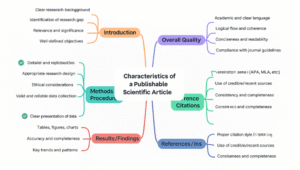TOPIC 2: INVESTIGATING PRACTICES AND CONVENTIONS IN SCIENTIFIC ARTICLE WRITING
T.2.1 Brainstorming
In the previous meeting, you conducted interviews with journal editors, reviewers, or experienced authors to explore their perspectives on scientific article writing. Now, in this session, students are asked to share your group’s findings with the class. To make your presentation clear and effective, follow these steps with your group:
🔹 Step 1: Share | Present the key insights from your interview (e.g., process, challenges, article quality, or resources).
🔹 Step 2: Explain | Tell the class why these insights are important for understanding the practices and conventions of scientific article writing.
🔹 Step 3: Connect | Relate your findings to your own needs as a student writer, and suggest questions or ideas to explore in the next activity.
At this stage, you will reflect on and explore the insights gained after listening to other groups’ presentations of their interview findings. The goal is to deepen your understanding of scientific writing practices and identify patterns across different groups’ experiences.
- This topic is empty.
- You must be logged in to reply to this topic.
T.2.2 Individual Exploration
At this stage, students are encouraged to explore new materials that can deepen their understanding of scientific writing practices. The focus is on connecting their previous interview findings with authentic resources from reputable journals. Two key resources are provided: Journal Guidelines and Sample Articles. Both of these resources serve as practical tools to help students see the expectations of academic publishing and how those expectations are realized in real publications.
The transition from interview results to written guidelines and published articles is important. Interviews provide insights into the experiences of editors, reviewers, and published authors, while guidelines and articles show how those insights are applied in practice. By combining both, students will be able to understand the process of writing and publishing not only from theory and opinion but also from actual evidence.
2.3.1 Journal Guidelines
Journal guidelines are official instructions issued by publishers to ensure that all submitted articles meet professional and academic standards. These guidelines usually include details about article length, required structure (such as title, abstract, introduction, methods, results, discussion, and conclusion), citation and referencing style, formatting rules, and ethical considerations like plagiarism and originality.
For students, studying journal guidelines provides a clear picture of what editors and reviewers expect from a manuscript. It also emphasizes that successful publication is not only about having strong research ideas but also about presenting them in a way that matches the journal’s standards.
In this subsection, students will:
- Review Author Guidelines from reputable journals in English Language Education.
- Identify similarities and differences in structure, formatting, and referencing style.
- Discuss why following journal guidelines is essential for publication success.
To illustrate this more concretely, below is an excerpt from the Author Guidelines of two respected journals:
- Indonesian Journal of Applied Linguistics (IJAL), a Q2-ranked journal in the field of linguistics and language education (IJAL Author Guidelines):
- Meanwhile, Cakrawala Pendidikan, an international education journal indexed in Scopus Q3, presents its Author Guidelines in two parts: a Journal Template and a Prior Submission Checklist, both of which guide authors in preparing manuscripts that meet the journal’s requirements Cakrawala Pendidikan Author Guidelines
While journal guidelines provide a theoretical framework of what editors expect, published articles show how those guidelines are applied in real writing. To gain a more practical understanding, students need to analyze sample articles from reputable journals.
2.3.2 Sample Journal Articles
Sample articles from peer-reviewed, high-quality journals offer students concrete examples of publishable work. By studying them, students can observe how authors organize their articles, develop arguments, use evidence, and follow the journal’s specific requirements. These articles also serve as models of clarity, coherence, and academic style that students can learn from and adapt to their own writing.
Reading sample articles also helps students make connections between the written guidelines and actual practice. For instance, if a guideline specifies that the abstract must summarize objectives, methods, results, and implications, students can look at how each published article structures its abstract accordingly.
In this subsection, students will:
- Read selected articles from reputable journals in English Language Education.
- Observe how each section of the article (abstract, introduction, methods, results, discussion) is written.
- Compare published articles with journal guidelines to identify consistency and differences.
To illustrate this more clearly, the following is an excerpt from a published article in a reputable journal.
- The article “The Mediating Role of Academic Emotions in the Relationship Between Classroom Environment and Self-Regulated Learning” by Yuan Fang and Syamsiara Failasofah, published in the Indonesian Journal of Applied Linguistics (IJAL), can be accessed in full at this link
By analyzing both journal guidelines and sample articles, students gain a comprehensive understanding of scientific writing expectations. Guidelines provide the rules, while sample articles provide real applications. Together, these resources equip students with the knowledge they need to prepare their own manuscripts that meet academic publishing standards.
- This topic is empty.
- You must be logged in to reply to this topic.
This activity helps you connect real-world experiences from interviews with formal standards and best practices in scientific publishing, enhancing your critical thinking and understanding of high-quality scientific writing.
T 2.3 Sharing and Discussion
In this section you are required to organize and visualize the key characteristics of a high-quality scientific article that can be published in reputable journals, based on your interview insights and the provided materials (author guidelines and sample articles).
- This topic is empty.
- You must be logged in to reply to this topic.
T.2.4 Drafting and Refining
Choose one mind map created by another group and compare it with your own. Identify at least three similarities, three differences, and two new insights you gained from the comparison. Summarize your findings in a short written report (about 300–400 words) and be ready to share them in class discussion.
